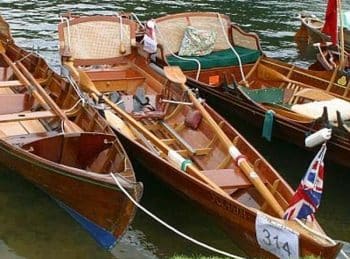
Different designs of traditional Thames rowing boats have different functions.
The Thames skiff, the wherry and the gig are all closely related to each other.
The Thames wherry was the tool of the professional boatman and for many centuries was London’s taxi service. The Thames gig was the racing version: light weight and fitted with the familiar rowlocks or outriggers on the gunwale. Rowlocks are more properly called crutches, but like so many nautical terms, definitions and their usage vary widely.
BAE 0072 is typical of the type used primarily for leisure purposes and as family boats on the non-tidal part of the Thames. Their design is derived from the same shape and construction of the large ceremonial barges used by the livery companies and passenger wherries. They were built in large numbers during the 19th and 20th centuries, with many still in use today. It was this type of craft that was used in Jerome K. Jerome’s book Three Men In A Boat. These skiffs were designed for sleeping aboard, with a canvas cover supported by metal hoops and enough room for cooking equipment and provisions, enabling journeys by river of several days.
The skiff in the Museum’s collection was built by Hammerton of Thames Ditton in 1905: all its equipment is original, including part of the original cane in the stern seat.
Dimensions:
Length 7.95m
Beam 1.4m
Depth 0.89m


